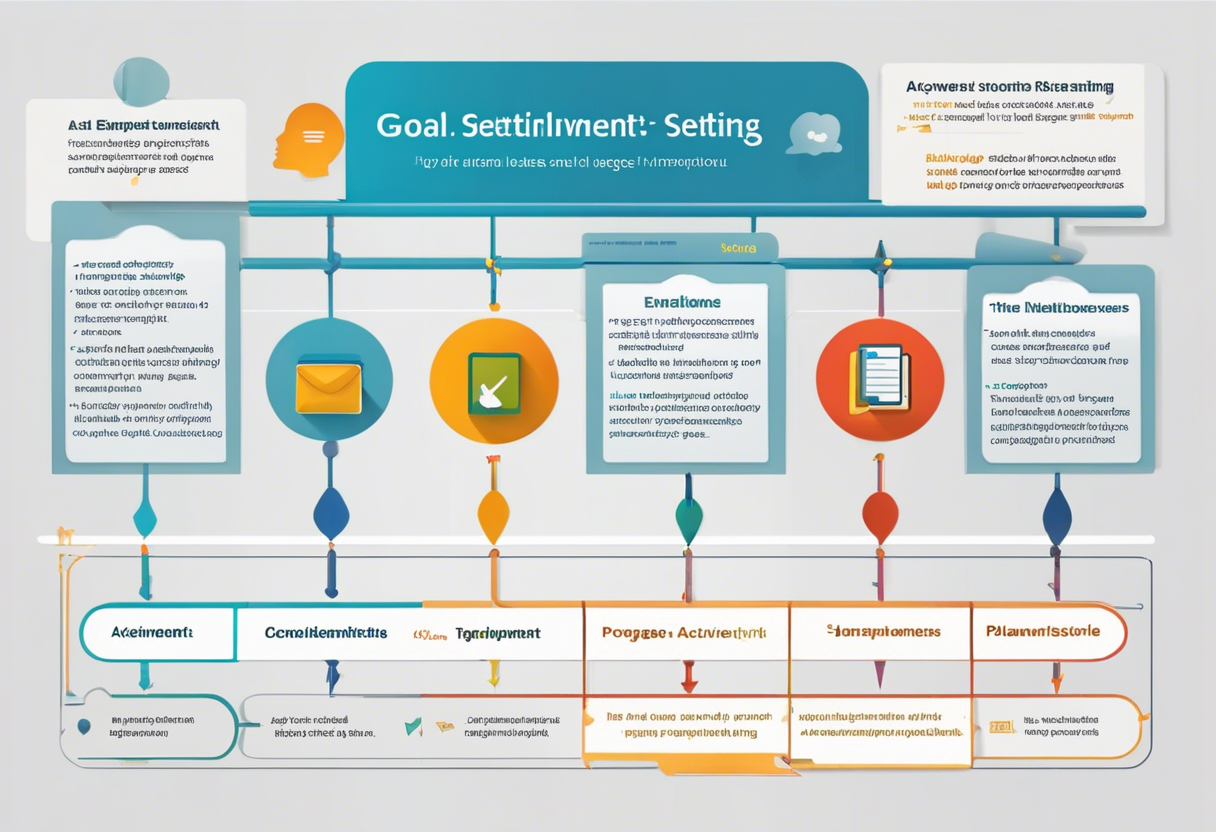Law Of Attraction
Here’s an overview:
- The Importance of Setting Clear Goals
- Developing a Strategic Plan for Success
- Creating a Realistic Timeline for Achievement
- Identifying Potential Challenges and Solutions
- The Role of Accountability in Goal Achievement
- The Power of Positive Thinking and Visualization
- Seeking Support and Collaboration
- Overcoming Setbacks and Staying Motivated
- Celebrating Success and Setting New Goals
- Continuous Improvement and Growth
The Importance of Setting Clear Goals

Setting clear goals is essential for guiding individuals and organizations towards success. Here are some key points highlighting the importance of establishing clear goals:
- Direction and Focus: Clear goals provide a sense of direction and focus. They help individuals and teams understand what they need to achieve and the steps required to reach their objectives.
- Motivation and Commitment: When goals are well-defined, individuals are more motivated to work towards them. Clear goals create a sense of purpose and commitment, driving people to put in the effort needed to succeed.
- Measurable Progress: Having specific goals allows for progress tracking. By setting clear metrics and milestones, individuals can monitor their advancement and make any necessary adjustments along the way.
- Enhanced Decision-Making: Clear goals make decision-making easier. When individuals know what they are working towards, they can align their choices and actions with their objectives, helping them stay on the right path.
- Accountability: Well-defined goals create accountability. Individuals and teams are more likely to take ownership of their responsibilities when they have clear objectives to meet.
In summary, setting clear goals is crucial for providing direction, motivation, accountability, and focus. It enables individuals and organizations to make informed decisions, monitor progress, and ultimately achieve success.
Developing a Strategic Plan for Success

- Define Clear Objectives:
- Set specific, measurable, achievable, relevant, and time-bound (SMART) goals.
- Conduct a SWOT Analysis:
- Identify strengths, weaknesses, opportunities, and threats to inform strategy.
- Identify Key Performance Indicators (KPIs):
- Establish metrics to track progress and measure success.
- Develop Strategies and Tactics:
- Outline the actions needed to achieve the established goals.
- Allocate Resources Wisely:
- Ensure that personnel, finances, and time are dedicated efficiently.
- Monitor and Evaluate Progress:
- Regularly review performance against KPIs and adjust strategies as needed.
- Adapt to Changes:
- Remain flexible and responsive to external factors that may impact the plan.
By following these steps and continuously refining the strategic plan, businesses can enhance their chances of success and navigate challenges effectively.
Creating a Realistic Timeline for Achievement

When setting goals, creating a realistic timeline is crucial for success. Here are some steps to help create a timeline that sets achievable milestones:
- Define Specific Goals: Outline clear and specific goals that are measurable. This will help in creating a timeline with concrete objectives.
- Break Down Tasks: Divide the overall goal into smaller tasks or steps. This will make the timeline more manageable and allow for incremental progress.
- Set Deadlines: Assign deadlines to each task or milestone. This will help in tracking progress and staying on schedule.
- Consider Resources: Take into account the resources available, such as time, money, and manpower, when creating the timeline. Realistic resource allocation is key to meeting deadlines.
- Be Flexible: Allow for some flexibility in the timeline to account for unexpected delays or obstacles. Adjustments may be necessary to maintain progress towards the goal.
- Regularly Review and Adjust: Periodically review the timeline to assess progress. Make necessary adjustments if tasks are taking longer than expected or if priorities shift.
By following these steps and creating a realistic timeline, individuals can effectively track their progress and stay motivated towards achieving their goals.
Identifying Potential Challenges and Solutions

- One potential challenge that may arise is a lack of communication between team members. This can lead to misunderstandings, delays in project completion, and overall decreased productivity. Implementing regular team meetings and encouraging open communication channels can help mitigate this challenge.
- Another challenge could be a lack of resources, such as budget constraints or limited access to necessary tools. To address this, project managers should carefully plan and allocate resources, explore cost-effective alternatives, and seek approval for additional resources when needed.
- Team conflicts may also present a challenge, affecting team dynamics and project progress. Encouraging a positive team culture, promoting respect among team members, and resolving conflicts promptly through mediation or team building activities can help manage this challenge effectively.
- Scope creep, where project requirements expand beyond initial expectations, is a common challenge that can lead to project delays and budget overruns. Setting clear project scopes, obtaining stakeholder approval for scope changes, and regularly reviewing project progress against initial requirements can help prevent scope creep.
- External factors such as changes in regulations or market conditions can also pose challenges to project success. Conducting thorough risk assessments, staying informed about external environments, and adapting project plans accordingly can help mitigate the impact of these external challenges.
“By identifying potential challenges early on and proactively developing solutions, project managers can enhance project outcomes and ensure successful project delivery.”
The Role of Accountability in Goal Achievement
Accountability plays a vital role in achieving goals successfully. Here are key points to understand its significance:
- Motivation Boost: When individuals are held accountable for their goals, it can serve as a powerful motivator. Knowing that they are answerable to someone or a group can push them to stay focused and committed to their objectives.
- Clarity and Focus: Establishing accountability helps individuals gain clarity on what they need to accomplish. By clearly defining roles, responsibilities, and timelines, individuals can stay on track and avoid distractions.
- Feedback and Support: Accountability provides a platform for receiving feedback and support. Whether it’s through regular check-ins or progress reports, having someone to hold them accountable can offer valuable insights, guidance, and encouragement.
- Ownership and Responsibility: Holding individuals accountable fosters a sense of ownership and responsibility for their goals. They are more likely to take proactive steps and make necessary adjustments to ensure success when they know they are answerable for their progress.
- Drive for Results: Ultimately, accountability drives results. It creates a sense of urgency and commitment to achieving the desired outcome. When individuals are held accountable, they are more likely to stay disciplined, overcome challenges, and persist until they reach their goals.
In conclusion, accountability is a cornerstone in the journey towards goal achievement. It not only enhances motivation and focus but also provides the necessary support and feedback for individuals to take ownership of their objectives and drive results effectively.
The Power of Positive Thinking and Visualization

- Positive thinking allows individuals to focus on their strengths and opportunities rather than dwelling on weaknesses and obstacles. This mindset can lead to increased resilience, improved problem-solving skills, and better overall mental health.
- Visualization is a powerful technique that involves picturing oneself achieving a specific goal or outcome. By envisioning success in detail, individuals can boost their confidence, motivation, and ability to perform at their best.
- When positive thinking and visualization are combined, they create a potent force for personal growth and success. By cultivating a positive mindset and regularly visualizing success, individuals can overcome challenges, stay motivated, and achieve their goals more effectively.
- Positive thinking and visualization can also help individuals manage stress, reduce anxiety, and increase feelings of happiness and well-being. By focusing on positive outcomes and visualizing success, individuals can rewire their brains to become more optimistic and resilient in the face of adversity.
- To harness the power of positive thinking and visualization, individuals can incorporate daily affirmations, gratitude practices, and visualization exercises into their routines. By consistently reinforcing positive thoughts and images, individuals can train their minds to focus on success and possibility rather than failure and limitation.
Positive thinking and visualization are not just fleeting thoughts or daydreams; they are powerful tools that can transform beliefs, behaviors, and outcomes. By embracing positivity and actively envisioning success, individuals can tap into their full potential and create the life they desire.
Seeking Support and Collaboration

When seeking support and collaboration, it is vital to establish clear communication channels and define expectations from the outset. Collaboration thrives on trust, transparency, and open communication. This section will delve into ways to effectively seek support and collaboration in various settings.
- Identifying Potential Collaborators: Before reaching out for support or collaboration, it is crucial to identify individuals or organizations that align with your goals and values. Networking events, professional organizations, and online platforms can be valuable resources for finding like-minded collaborators.
- Articulating Your Needs: Clearly articulating your needs and objectives when seeking support is essential for others to understand how they can assist you. Whether you require financial backing, expertise, or resources, being specific about your requirements will help potential collaborators determine how they can contribute.
- Building Relationships: Building strong relationships is at the core of successful collaboration. Taking the time to understand the strengths and interests of potential collaborators can pave the way for mutually beneficial partnerships. Engaging in open dialogue and actively listening to others’ perspectives can foster trust and respect within the collaboration.
- Establishing Mutually Beneficial Agreements: When seeking support or collaboration, it is crucial to establish mutually beneficial agreements. Clearly outlining roles, responsibilities, and expectations can help prevent misunderstandings and conflicts down the line. Developing a formal agreement or memorandum of understanding can provide a framework for the collaboration’s success.
- Maintaining Communication: Regular communication is key to sustaining successful collaborations. Providing updates, sharing progress, and addressing any challenges promptly can help maintain momentum and ensure that the collaboration stays on track towards achieving its goals.
Seeking support and collaboration is a collaborative effort that requires clear communication, mutual respect, and a shared vision for success. By proactively engaging with potential collaborators and fostering strong relationships, individuals and organizations can harness the power of collaboration to achieve their objectives effectively.
Overcoming Setbacks and Staying Motivated

- Maintaining a Positive Mindset: It is crucial to remember that setbacks are a natural part of any journey. By adopting a positive mindset, individuals can view setbacks as opportunities for growth and learning. This mentality shift can help in staying motivated despite obstacles.
- Setting Realistic Goals: To overcome setbacks, individuals should revisit and potentially adjust their goals to ensure they are realistic and attainable. By breaking down larger goals into smaller, manageable tasks, individuals can maintain motivation by celebrating each small accomplishment.
- Seeking Support: During challenging times, seeking support from friends, family, or mentors can provide encouragement and guidance. Surrounding oneself with a supportive network can help individuals stay motivated and focused on their goals.
- Learning from Setbacks: Instead of viewing setbacks as failures, individuals should see them as opportunities to learn and improve. Reflecting on what went wrong and how to do things differently in the future can be invaluable in overcoming setbacks.
- Staying Consistent: Consistency is key in maintaining motivation. By establishing a routine and sticking to it, individuals can build momentum and resilience to face setbacks head-on. Consistent effort, even in the face of challenges, can lead to long-term success.
- Practicing Self-Care: Taking care of physical and mental well-being is essential in overcoming setbacks. Engaging in activities that promote relaxation, such as exercise, meditation, or hobbies, can help individuals recharge and regain motivation to continue pursuing their goals.
By implementing these strategies, individuals can navigate setbacks effectively and stay motivated on their path towards success.
Celebrating Success and Setting New Goals

In this section, the focus is on acknowledging achievements while also looking towards the future with fresh objectives. Here are some key points to consider:
- Reflect on Accomplishments: Take the time to celebrate the milestones and successes achieved so far. Recognizing hard work and dedication is essential for morale and motivation.
- Share Successes: Share achievements with team members, colleagues, or mentors. Celebrating success together fosters a sense of camaraderie and unity.
- Set New Goals: After celebrating success, it is important to set new goals to maintain momentum. These goals should be challenging yet achievable to keep the motivation high.
- Create a Plan: Developing a detailed plan to reach new goals is crucial. This plan should outline specific steps, timelines, and responsibilities to ensure accountability.
- Track Progress: Monitoring progress towards new goals is essential for staying on track. Regularly assess and adjust strategies to overcome obstacles and ensure continued success.
- Celebrate Small Wins: Acknowledge and celebrate small victories along the way. By recognizing incremental progress, motivation remains high, leading to greater overall success.
- Stay Flexible: While setting new goals is important, it is also vital to remain flexible. Be open to adjusting goals and strategies based on feedback and changing circumstances.
By celebrating past achievements and setting new goals with a clear plan in place, individuals and teams can maintain momentum and continue to achieve success in the future.
Continuous Improvement and Growth

Continuous improvement is a vital aspect of achieving sustained success. It involves constantly reassessing processes, strategies, and outcomes to identify areas for enhancement. By embracing a culture of continuous improvement, organizations can adapt to changing environments, stay ahead of the competition, and deliver better results to their stakeholders.
Ways to Foster Continuous Improvement and Growth:
- Encourage Innovation: Encouraging a workplace environment that fosters innovation is crucial for continuous improvement. By promoting creativity and risk-taking, organizations can uncover new ideas and solutions that drive growth.
- Set Clear Goals and Objectives: Establishing clear and measurable goals is essential for tracking progress and identifying areas that need improvement. Regularly reviewing and adjusting these goals ensures that the organization stays on the path to growth.
- Implement Feedback Mechanisms: Feedback from employees, customers, and stakeholders provides valuable insights into areas that need improvement. Implementing robust feedback mechanisms allows organizations to address issues promptly and make necessary changes.
- Invest in Employee Development: Investing in training and development programs for employees not only enhances their skills but also contributes to organizational growth. Employees who are continuously learning and growing bring fresh perspectives and ideas to the table.
- Embrace Technology: Embracing new technologies can streamline processes, improve efficiency, and drive innovation. Staying abreast of technological advancements in the industry can give organizations a competitive edge and support continuous improvement efforts.
Continuous improvement and growth are ongoing processes that require dedication, collaboration, and a commitment to excellence. By prioritizing improvement initiatives and fostering a growth mindset across all levels of the organization, businesses can position themselves for long-term success and sustainability.






